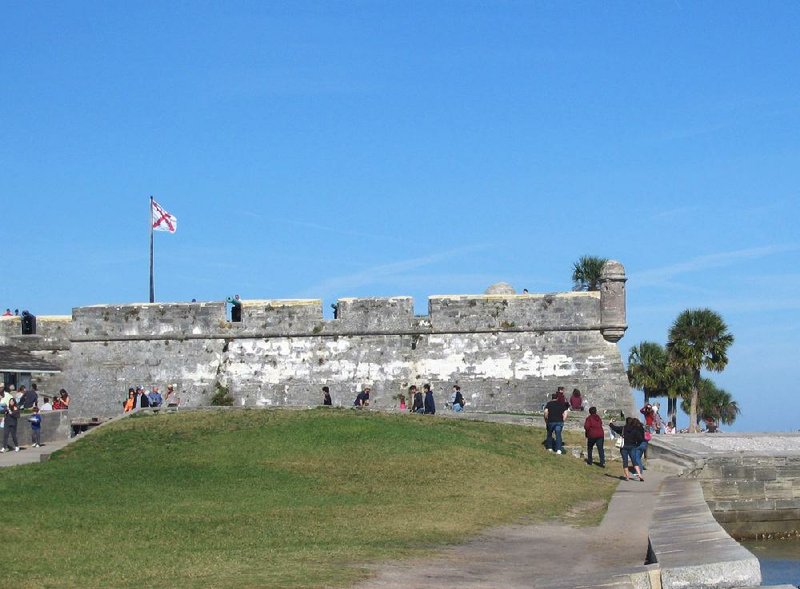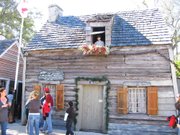ST. AUGUSTINE, Fla. - History may not be the first thing that comes to mind while basking on a Florida beach, but a 500th birthday is good reason to sit up and take notice.
It has been 500 years since Spanish explorer Ponce de Leon sighted land in the New World on April 2, 1513, over a century before the Pilgrims landed at Plymouth Rock. Since it was Easter season, which Spaniards called “Pascua Florida” (Festival of Flowers), he named his find La Florida and claimed the land for Spain.
All of the state is marking the date this year, but nowhere more than St. Augustine, the city just south of the spot where de Leon landed. The oldest permanent settlement in the United States, the city itself was founded a bit later by Pedro Menendez de Aviles who followed de Leon in 1565. He landed Aug. 29, the feast day of St. Augustine.
This is a town well worth exploring any time, filled with charm and the legacies of a rich heritage that extended from Colonial times into the grand Victorian Gilded Age. Adding to the attractions is a newly revitalized Colonial Quarter opened in March to mark the state’s 500th anniversary, a chance to experience life in St. Augustine as it was in the 16th, 17th and 18th centuries.
One major historic attraction is the Castillo de San Marcos National Monument, the oldest masonry fort in the continental United States. The Spanish constructed the fort beginning in 1672 to protect against repeated pirate attacks. It took 23 years to complete the massive structure with its moat and an inner drawbridge, watchtower and diamond-shaped bastions at each of the four corners. It has been restored along with the original City Gate and some of the city walls. Walk up to the gun deck to see original cannons and a wonderful view of the city and the bay.
Much of the early town burned in a fire in 1702, but it was quickly rebuilt. A stroll along St. George Street, not far from Castillo de San Marcos, takes you by the Oldest Wooden Schoolhouse, first appearing on the tax rolls in 1716 and the city’s oldest surviving wood frame building. It may or may not be the nation’s oldest wooden schoolhouse, but is an excellent example of wooden construction in the early 1700s. It is populated with life-size figures of the professor and pupils.
Costumed guides take visitors through the new Colonial Quarter to see how soldiers and families lived through the centuries under five flags, with reconstructed homes and demonstrations of blacksmithing, leatherworks, a Colonial print shop, musket firing and a replica 16th-century sailing ship under construction. Climb the 17th-century watchtower replica for a peerless view.
Pedestrians-only St. George Street eventually turns into a shopping street crowded with tourists. But beyond the shops it leads to more history at the Central Plaza, laid out in 1598 and filled with monuments and memorials. The Government House off the Plaza was the residence of Colonial governors for 200 years. It is now a museum of local history and also houses the city’s information center. The Cathedral-Basilica of St. Augustine facing the plaza, originally built in the 1790s, is the seat of the oldest Catholic parish in the nation. Trinity Episcopal Church, dating to 1825, was Florida’s first Episcopal Church and has a Tiffany stained-glass window in the chapel.
The Old Market at the end of the plaza was constructed in 1824 on a site that had been a public market since 1598. Beyond is a statue of de Leon and across the road is the Bridge of Lions, leading to the beaches across the bay. The handsome bridge adorned with Mediterranean Revival towers was built in 1926 to replace a wooden bridge.
The most picturesque residential section of the city, Old Town, is a delightful stroll along narrow brick streets and walkways lined with stone walls, and wonderful old houses with overhanging balconies. Many of the homes are among the town’s 30-plus art galleries. The Oldest House Museum Complex, operated by the St. Augustine Historical Society, features the Gonzalez-Alvarez House, the oldest surviving Spanish Colonial dwelling in Florida. The site has been occupied since the 1600s and the present house dates to the early 1700s. The complex includes gardens, a historical museum and a museum store. The Dow Museum of Historic Houses is a collection of homes that traces architecture from 1790 to 1910 in a complex that also includes gardens and statuary.
The last three decades of that collection coincide with St. Augustine’s “Gilded Age.” It began when Henry Flagler, one of John D. Rockefeller’s partners in Standard Oil, visited in 1883, and was impressed with the town’s possibilities as a resort. He had two lavish hotels built and bought a third. The grandest, the 1888 Alcazar Hotel, featured health spas, a gymnasium, steam baths and the world’s largest indoor pool. It was a mecca for society until it was done in by the Depression. Otto Lightner, the founder of Hobbies Magazine, restored the building in 1948 and turned it into the Lightner Museum to house his eclectic collections of Victoriana - an intriguing mix of furnishings, sculpture, paintings, mechanical musical instruments, toys and a fine selection of glassware that includes work by Tiffany.
Across the street, the Spanish Renaissance building that was the Hotel Ponce de Leon is now the main building of Flagler College. Take a tour to see highlights like the dining hall featuring 79 Tiffany windows and the Flagler room with eight chandeliers by Tiffany. The third hotel, the Casa Monica, was bought by Flagler and renamed The Cordova. It has been renovated and reopened in 1999 with the original name.
The Memorial Presbyterian Church at the corner of Valencia and Sevilla streets was built by Flagler in 1889 in Venetian Renaissance style with an imposing 100-foot dome as a memorial to his only daughter. He and his daughter are buried in the mausoleum.
For something completely different, don’t miss the St. Augustine Alligator Farm Zoological Park, one of the area’s most popular attractions. In addition to alligators, it is the only place in the world to see all 23 species of living crocodiles.
Historians have debunked the theory that de Leon was searching for the Fountain of Youth, but a touristy Fountain of Youth National Archeological Park claims to have been his original landing place. There is no proof that the awful-tasting water will restore your youth.
You can be sure, however, that the lavish beaches across the bay on Anastasia Island have restorative powers, and you can thank de Leon for finding them.
Travel, Pages 70 on 08/25/2013


